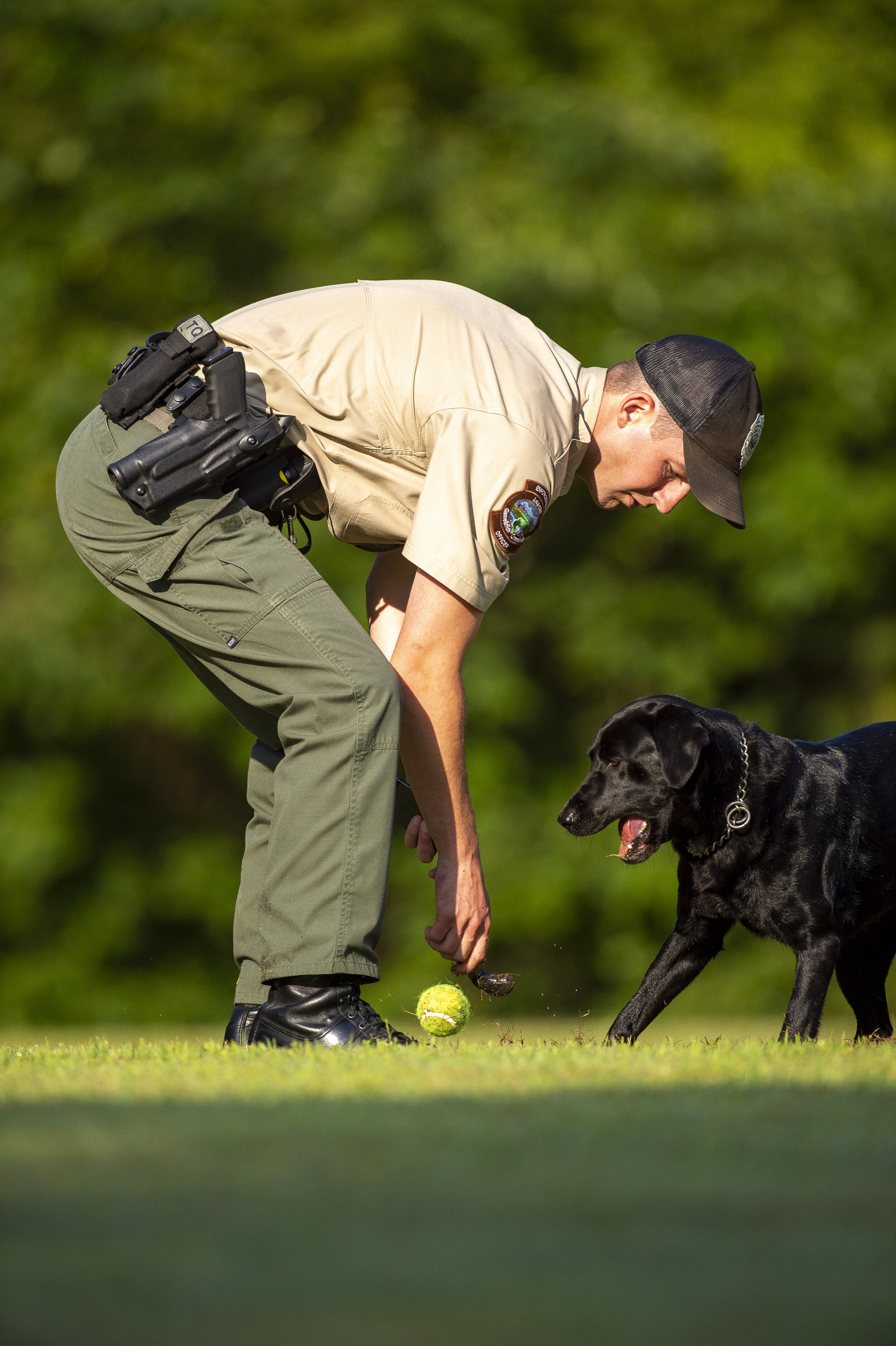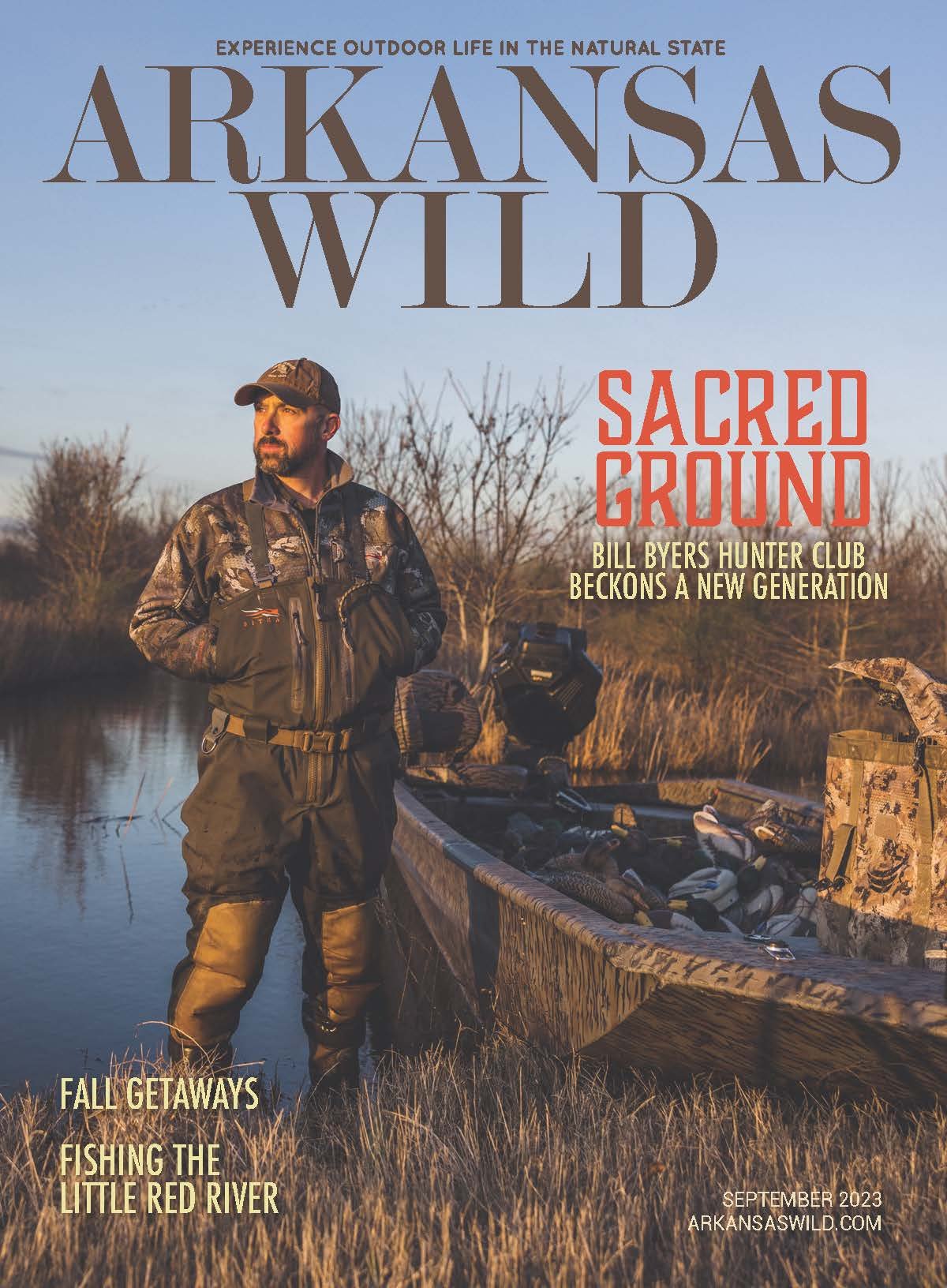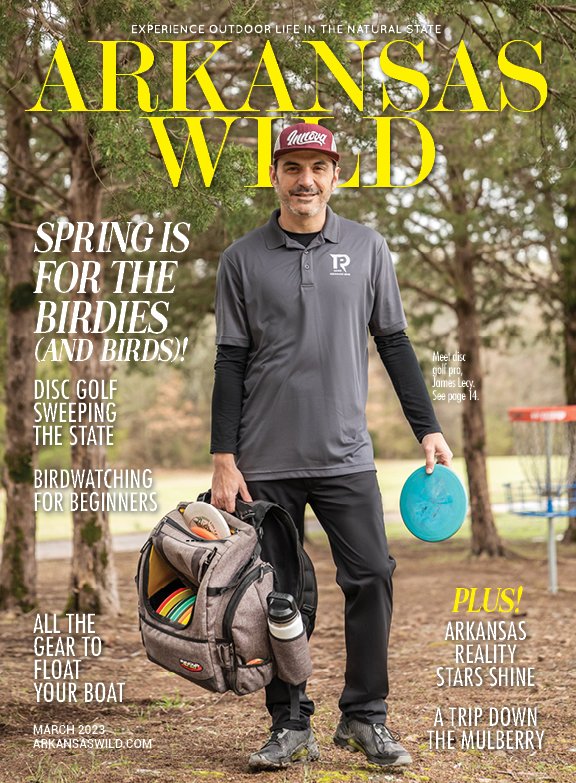Top Cops, Best Friends:
AGFC K-9 Unit Stands TallBy Drew Harris
Cpl. Landon Mills and K-9 Officer June, a 4-year-old black Lab, take a break between drills.
By any measurement, K-9 Officer Lucy and Cpl. Gary Don Stell of the Arkansas Game and Fish Commission K-9 Unit are bona fide heroes. Last year, the duo was awarded multiple citations for valor in the line of duty that saved lives; two in 2019 alone. They have been similarly recognized by the Arkansas Attorney General’s office, National Wild Turkey Federation and multiple local sheriff’s departments in Arkansas, not to mention making the cover of Arkansas WILD as 2019 Champion of the Wild honorees.
As part of the AGFC’s unit, Stell and Lucy are one of 10 elite canine-human officer teams that are versatile tools for enforcing game laws and serving the public.
“Our Game and Fish Commission Enforcement Division is divided into 12 districts, and 10 of those 12 districts currently have K-9s,” said Special Operations Lt. Brian Aston. “They have regular patrol responsibilities within their assigned county, but within their assigned district and associated municipalities they assist with everything from felony tracking to evidence recovery, homicide investigations, to addressing Game and Fish violations. They will also track persons who get lost.”
All of the K-9s currently on duty are Labrador retrievers, favored specifically for their individual breed attributes.
“With a Lab, in my opinion, their nose is hard to beat,” said Cpl. Landon Mills, who partners with a 4-year-old black Lab named June. “You can put some of the shepherds and the Malinois up there with them, but a Lab’s nose is going to be superior.
“They’re going to be able to pick a track up and follow it a long way, even being several hours old. Any item that’s got human scent on it or gunpowder residue, they’re going to be able to pick that up on the wind a lot farther than most dogs can.”
Aston said the dogs’ roles as brand ambassadors for AGFC also figured into using Labradors, noted for their mild temperament.
“These canines, a big portion of what they do is public relations,” he said. “During calendar year 2019, our canine units came in contact with 28,000 Arkansans. The reason we primarily use Labs is because of their ability to be multifunctional. Secondly, it’s because most people have a memory, association or affiliation that they can connect with that canine.
“At these public relations events, people can make a connection with an officer that’s personal, especially children. It bridges the gap between officers and civilians who might not otherwise think favorably of law enforcement.”
The dogs serving in the unit generally enter the training program between ages 1-2 and come from a variety of backgrounds.
“The more you run them, the better they are.” Cpl. Mills and K-9 June go through their paces during recent training exercises.
“We get dogs that have some training when they get here and some that don’t have any training. We have some of both,” said Stell, who is also the program coordinator. “We’ve got some that were high-dollar retrievers, you know, duck dogs. And we got some that came out of the pound. We got one that came through as a rescue dog out of Florida.”
Aston said, “We don’t have a specific kennel that we deal with. These dogs are acquired through whichever means available. We look for certain attributes within the dog, and if they meet the parameters, then we’ll progress with the training.
“Once we find a dog and they meet those parameters, we’ll look at acquiring that dog. The last two we got were donations. And we’ve had some purchases, too, throughout the years.”
Upon entering the program, the dog is paired with a human partner and the two complete 500 hours of basic training together. But that’s not the end of the team’s interaction.
“When you’re assigned a K-9, they stay with you 24/7,” Mills said. “We’ve got some that are outside dogs, some that are inside. I think the majority of the ones that we have now are living inside the house with family. [The dogs] stay with us from the time we’re assigned to them until they retire and then we’re allowed to keep them after that as well.”
Stell said, “These dogs are just like a family member to us, all the handlers. If somebody puts their hands on them, it’s just like them trying to fight us.”
Continuing education is a fact of life in the K-9 unit, to keep both two- and four-legged officers sharp and up to date on the latest criminal threats and police tactics. Last year, the K-9s and their handlers completed more than 2,000 hours of training.
“A lot of it is scenario-based,” said Aston, who worked with a K-9 partner in the unit for two years before moving into administration two years ago. “Once the K-9s have reached a level of proficiency, the dogs are introduced to different scenarios that our seasoned officers have encountered over the years. This prepares the K-9 as well as the handler on how to address situations that they might encounter during their patrol work.
“The hardest part about using a Lab is getting the Lab with his head on the track. They’re bred to hunt waterfowl, and so you’re taking your dog’s natural desire and trying to mold that into what we want, tracking being the hardest. That’s what we start with first.”
With just one K-9 team for every enforcement district in the state, getting into the unit is a highly competitive process.
“We’re not normal law enforcement officers reacting to calls,” Mills said. “We’re more along the proactive side where we’re going and trying to drum up stuff, doing investigations out on our own. With a canine, you have to be that much more self-motivated because, in addition to your patrol and work as a game warden, you’ve got your partner there that requires a lot of training outside of what we do with just normal training.
“You’ve got to be doing something with them pretty much every day to keep that skill honed. The more you train them, the more you run them, the better they are.”





